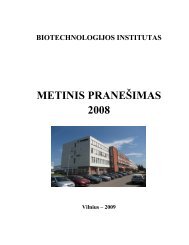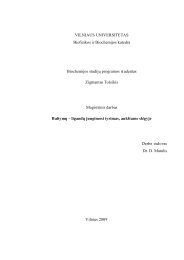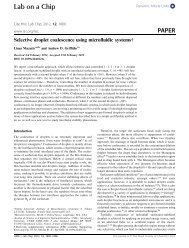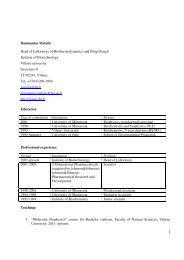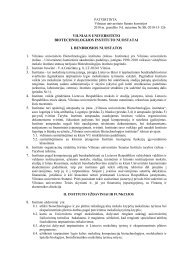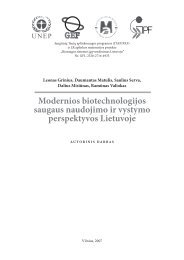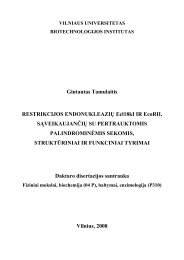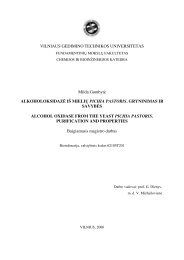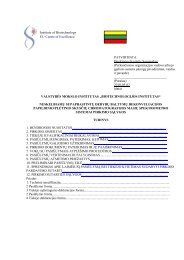Report 2008-2010
Report 2008-2010
Report 2008-2010
You also want an ePaper? Increase the reach of your titles
YUMPU automatically turns print PDFs into web optimized ePapers that Google loves.
For that purpose 93 serum samples were tested by indirect and capture<br />
assays. The level of IgG and IgM antibodies was measured. The<br />
serum specimens tests results were compared with commercially available<br />
Progen Hantavirus IgG and IgM detection kit (Heidelberg, Germany).<br />
By comparison serum results with the Progen kit the sensitivity<br />
of IgG and IgM indirect ELISA assays was 100%, the specificity 97.3%<br />
for IgM test and 100% for IgG test. Comparing the capture assay with<br />
Progen kit results the sensitivity was 100% for IgM assay and 80% for<br />
IgG assay. The specificity of IgM capture assay was 97.3% and 95% of<br />
IgG capture assay. In summary, the results of the tests using recombinant<br />
protein were concordant with Progen test and the yeast expressed<br />
N protein is suitable for hantaan diagnostics.<br />
Characterization of monoclonal antibodies against hantavirus nucleocapsid<br />
protein and their use for immunohistochemistry on rodent<br />
and human samples<br />
Monoclonal antibodies are important tools for various applications<br />
in hantavirus diagnostics. Recently we have generated Puumala virus<br />
(PUUV)-reactive monoclonal antibodies (mAbs) by immunization of<br />
mice with chimeric polyomavirus-derived virus-like particles (VLPs)<br />
harboring the 120 amino acids-long amino-terminal region of PUUV<br />
nucleocapsid (N) protein. Here we describe the generation of two<br />
mAbs by co-immunisation of mice with hexahistidine-tagged fulllength<br />
N proteins of Sin Nombre virus (SNV) and Andes virus (ANDV),<br />
their characterization by different immunoassays and comparison with<br />
the previously generated mAbs raised against a segment of PUUV N<br />
protein inserted into VLPs. All mAbs reacted strongly in the ELISA and<br />
Western blot test with the antigens used for immunization and crossreacted<br />
to varying extents with N proteins of other hantaviruses. All<br />
mAbs raised against a segment of PUUV N protein presented on<br />
chimeric VLPs and both mAbs raised against the full-length AND/SNV<br />
N protein reacted with Vero cells infected with different hantaviruses.<br />
The reactivity of mAbs with native viral nucleocapsids was also confirmed<br />
by their reactivity in immunohistochemistry assays with kidney<br />
tissue specimens from experimentally SNV-infected rodents and<br />
human heart tissue specimens from hantavirus cardiopulmonary syndrome<br />
patients. Therefore the described mAbs represent useful tools<br />
for the immunodetection of hantavirus infection.<br />
Biotechnological approaches to improve plant cold tolerance<br />
This project was supported by the Lithuanian State Science and Studies<br />
Foundation grant N-07014. Project participants: Institute of<br />
Biotechnology, Institute of Horticulture and University of Agriculture.<br />
An economical value and competitiveness of the important and industrial<br />
energy crops rape (Brassica napus), Miscanthus and horticultural<br />
plants as a source of colorants, medical and food compounds<br />
and their rootstocks is reduced by limited adaptation – winter hardiness<br />
and cold adaptation in Lithuania. The aim of this project was<br />
combine an experience of the participants in research on industrially<br />
important plants, gene engineering, and development of cold resistant<br />
plant selection technologies. The main goal of this integrated project<br />
was to develop transgenic plants with improved cold hardening<br />
and resistance properties. In addition, genetic transformation of the<br />
plants require prior investigation of traits implicated in cold hardiness<br />
that could be used to assess effects of interaction of transgenes with<br />
the endogenous mechanisms controlling acclimation processes.<br />
The best known and probably the most cold-specific CBF/DREB cold<br />
resistance pathway was studied in Brassica napus. By homology-based<br />
PCR, analogs of cold inducible transcription factors CBF, ICE and MYB<br />
from B. napus were cloned. Transgenic lines of model plant A. thaliana<br />
have been constructed and were used in function analysis of BnCBF,<br />
BnICE and BnMYB in Arabidopsis. Proposed function of the BnICE<br />
protein as transcription factor was supported by the finding that it is<br />
localised in nucleus.<br />
Figure 4. Expression of Bn-ICE-GFP in roots of transgenic A.<br />
thaliana 35S:BnICE-GFP plants. Green fluorescence - GFP, red fluorescence<br />
- propidium jodide stained cell walls.<br />
35 th anniversary<br />
32



